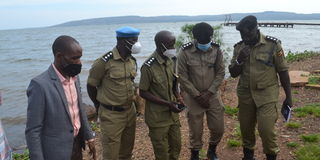Prime
3,500 Ugandans have drowned in three years - report

The Executive Director Swim Safe Uganda, Mr Moses Kalanzi, joins police officers the officer on inspection of the ground where locals underwent a 10-day training on rescuing drowning victims at Masese Landing Site in Jinja City on December 8, 2021. PHOTO | DENIS EDEMA
What you need to know:
- From the findings, it emerged that drowning cases were recorded in the area police offices, marine police detachments, fire or rescue brigade detachments, and mortuaries, while the availability of information on the characteristics of the person who drowned and circumstances of the drowning incident varied by source.
At least 3,500 Ugandans across 74 districts are reported to have drowned over a two and half year period, according to a study conducted by Makerere University’s School of Public Health.
The study, which was conducted in two phases between January 1, 2016 and June 30, 2018, was made public in Jinja City by Mr Fredrick Oporia, a lecturer at the School.
During the first phase covering 60 districts, a total of 1,435 drowning cases were recorded, while 2,066 cases were identified by village health teams (VHTs) and confirmed through individual interviews, witness or survival and family accounts in 14 districts.
The district selection was based on the 2014 census and each select district either bordered one of the four major lakes, including Lake Victoria, Lake Albert, Lake Edward and Lake Kyoga, or didn’t.
The study revealed that the number of deaths identified per district ranged from 30 to 287 in lakeside districts and from 47 to 123 in non-lake districts.
“According to the studies of the report, Uganda globally is unfortunate as it suffers highest drowning rates because our capacity (to mitigate drowning) is still low; looking at the lakeside fishing communities, the death rate due to drowning is higher in Uganda,” Mr Oporia said.
The objective of the study was to establish the availability of drowning data in district-level sources and understand the reporting of and record keeping on drowning in Uganda, to describe the burden and circumstances of drowning in select districts and identify potential contextually-appropriate interventions for drowning prevention in select districts.
From the findings, it emerged that drowning cases were recorded in the area police offices, marine police detachments, fire or rescue brigade detachments, and mortuaries, while the availability of information on the characteristics of the person who drowned and circumstances of the drowning incident varied by source.
Mr Moses Kalanzi, the executive director of Swim Safe Uganda, said available data indicates that Uganda is one of the leading in the upper quartile for drowning and since 2017 he has been carrying out outreaches at which locals are taught water safety, fire safety and pre-hospital care skills.
“This intervention has been done through community outreaches in most at-risk landing sites and island communities in Wakiso, Kalangala, Buvuma, Lake Bunyonyi, Buliisa and Kasensero Landing Site in Kyotera district are some of the beneficiaries of the training,” said Mr Kalanzi.
In Busoga Sub-region, one such outreach, that started at Masese Landing Site, Jinja South division on December 8, was closed at the weekend by the Director Fire and Rescue Services in the Police Force, Assistant Inspector General of Police (AIGP) Joseph Mugisa.
Mr Mugisa told the over 80 trainees, who were successfully trained to respond to fire outbreaks among other emergencies, that the skills they had achieved could earn them a living.





